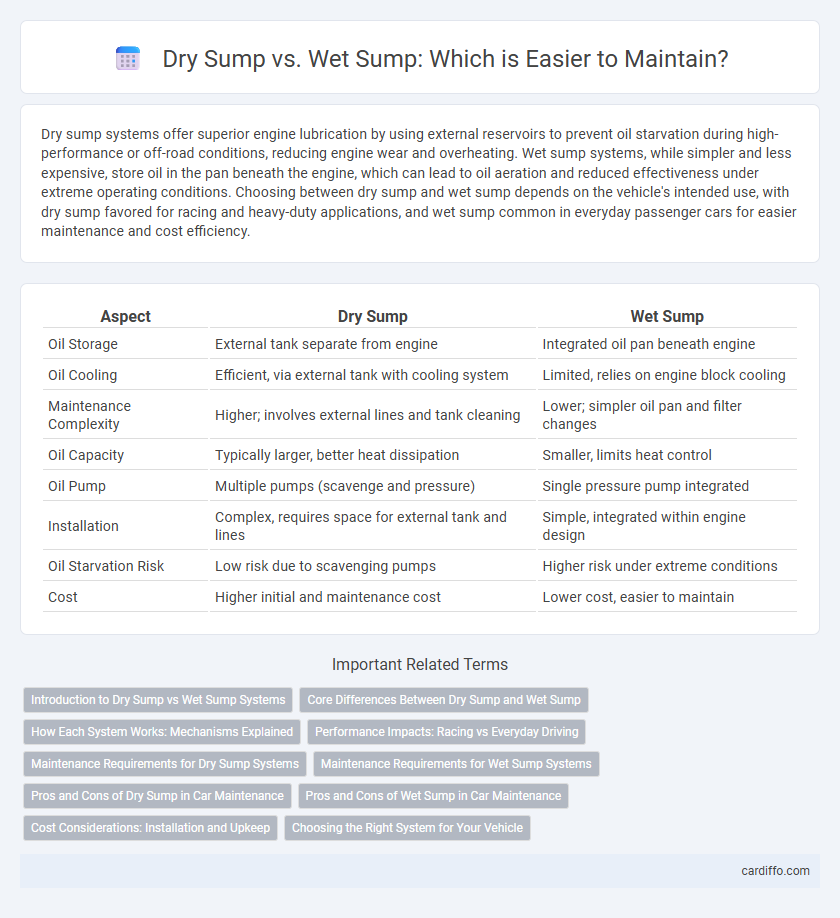Dry sump systems offer superior engine lubrication by using external reservoirs to prevent oil starvation during high-performance or off-road conditions, reducing engine wear and overheating. Wet sump systems, while simpler and less expensive, store oil in the pan beneath the engine, which can lead to oil aeration and reduced effectiveness under extreme operating conditions. Choosing between dry sump and wet sump depends on the vehicle's intended use, with dry sump favored for racing and heavy-duty applications, and wet sump common in everyday passenger cars for easier maintenance and cost efficiency.
Table of Comparison
| Aspect | Dry Sump | Wet Sump |
|---|---|---|
| Oil Storage | External tank separate from engine | Integrated oil pan beneath engine |
| Oil Cooling | Efficient, via external tank with cooling system | Limited, relies on engine block cooling |
| Maintenance Complexity | Higher; involves external lines and tank cleaning | Lower; simpler oil pan and filter changes |
| Oil Capacity | Typically larger, better heat dissipation | Smaller, limits heat control |
| Oil Pump | Multiple pumps (scavenge and pressure) | Single pressure pump integrated |
| Installation | Complex, requires space for external tank and lines | Simple, integrated within engine design |
| Oil Starvation Risk | Low risk due to scavenging pumps | Higher risk under extreme conditions |
| Cost | Higher initial and maintenance cost | Lower cost, easier to maintain |
Introduction to Dry Sump vs Wet Sump Systems
Dry sump and wet sump systems are two primary methods of engine lubrication, distinguished by oil storage and circulation techniques. Dry sump systems use an external reservoir and multiple scavenging pumps to circulate oil, providing improved oil control and cooling, especially in high-performance or race engines. Wet sump systems store oil in the engine's crankcase, using a single pump to circulate it, offering simplicity and cost-effectiveness suitable for most standard vehicles.
Core Differences Between Dry Sump and Wet Sump
Dry sump systems use an external reservoir to store oil, ensuring consistent lubrication and preventing oil starvation during high-performance or off-angle driving. Wet sump systems store oil directly in the engine's oil pan, offering simplicity and lower cost but risk oil starvation during extreme conditions. The core difference lies in oil storage location and management, with dry sumps providing superior oil control and wet sumps emphasizing ease of maintenance and cost efficiency.
How Each System Works: Mechanisms Explained
A dry sump system uses an external reservoir and multiple scavenge pumps to remove oil from the engine sump, ensuring consistent oil pressure and improved lubrication during high-performance or off-road conditions. A wet sump system stores oil in the engine's oil pan, where a single pump circulates the oil through engine components to provide essential lubrication under normal driving conditions. The dry sump's complex mechanism prevents oil starvation during extreme maneuvers, while the wet sump offers a simpler, more cost-effective solution for everyday maintenance.
Performance Impacts: Racing vs Everyday Driving
Dry sump systems enhance engine performance by maintaining consistent oil pressure during high-speed racing conditions, preventing oil starvation in sharp turns and aggressive maneuvers. Wet sump systems are simpler and adequate for everyday driving, providing sufficient lubrication under normal operating conditions but may suffer from oil aeration and starvation under extreme performance demands. Racing applications benefit from dry sump designs due to improved oil control and reduced parasitic drag, whereas wet sump systems prioritize cost-effectiveness and ease of maintenance for regular vehicles.
Maintenance Requirements for Dry Sump Systems
Dry sump systems require regular inspection and maintenance of external oil reservoirs, pumps, and associated plumbing to prevent leaks and ensure consistent oil circulation. Frequent oil changes and monitoring for contamination are crucial due to the system's increased complexity compared to wet sump designs. Proper maintenance prolongs engine life by maintaining optimal lubrication under high-performance or extreme operating conditions.
Maintenance Requirements for Wet Sump Systems
Wet sump systems require regular oil changes and filter replacements to maintain engine lubrication and prevent sludge buildup. Monitoring for oil leaks and ensuring proper oil levels are essential to avoid engine damage. The simpler design of wet sump systems generally results in lower maintenance complexity compared to dry sump systems.
Pros and Cons of Dry Sump in Car Maintenance
Dry sump systems offer improved oil control and reduced engine oil starvation during high-performance driving, making them ideal for racing and off-road vehicles. Their complexity and higher cost require specialized maintenance, including regular inspection of external reservoirs and additional pumps. However, dry sump designs enhance engine longevity by maintaining consistent oil pressure and reducing oil foaming compared to wet sump systems.
Pros and Cons of Wet Sump in Car Maintenance
Wet sump systems offer simpler design and lower cost, making them easier to maintain with readily accessible oil pans and pumps. However, they often suffer from oil starvation during aggressive driving or steep inclines due to oil sloshing away from the pickup, which can lead to engine wear. Regular oil changes and inspections are critical in wet sump systems to prevent sludge buildup and maintain optimal lubrication.
Cost Considerations: Installation and Upkeep
Dry sump oil systems typically involve higher initial installation costs due to the complexity of additional components like external reservoirs and multiple scavenging pumps. Maintenance expenses for dry sump setups can be greater, requiring specialized knowledge and periodic inspection of extra parts to prevent failure. Wet sump systems are generally more cost-effective to install and maintain, with simpler oil storage and fewer moving parts, resulting in lower overall maintenance expenditures.
Choosing the Right System for Your Vehicle
Choosing the right oil sump system for your vehicle depends on factors such as engine type, performance requirements, and maintenance preferences. Dry sump systems offer superior oil control and cooling, making them ideal for high-performance and racing vehicles, while wet sump systems are simpler, more cost-effective, and suitable for everyday driving. Evaluating your vehicle's usage and mechanical needs ensures optimal engine lubrication and longevity.
Dry Sump vs Wet Sump Infographic

 cardiffo.com
cardiffo.com